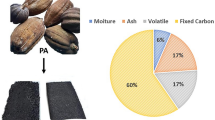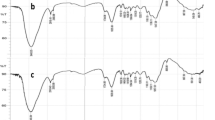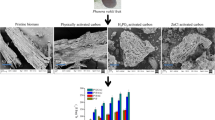Abstract
Plant-based biomass (CFB (carnauba fruit biomass)) obtained from the fruit exocarp of the species Copernicia prunifera (Mill.) H.E. Moore (carnauba) was evaluated for its viability as an adsorbent of potentially toxic metals in aqueous medium. The CFB was characterized by powder X-ray spectroscopy (XRD), scanning electron microscopy (SEM), Fourier transform infrared spectroscopy (FTIR), and zeta potential to investigate the morphology of the biosorbent and its interaction with water soluble metal ions of Pb and Cd. The biomass presents an amorphous structure, with negative zeta potential (− 2.59 mV), and the presence of functional groups such as O-H, C-O-C, C-H, and C=O. The removal potential of Pb(II) and Cd(II) was performed in a batch system, and monoelement solutions were tested to assess the effects of adsorbent dose and initial metal ion concentration, pH at the point of zero charge (pHPZC), sorption kinetics, and adsorption capacity. The most appropriate adsorbent concentration was 5 g/L, and sorption studies were carried out at pH 5.0 (pHPZC = 4.68), in which the surface of the adsorbent shows negative charges and favors the adsorption of metal ions. Kinetic studies showed that the pseudo-second order model best fit the experimental data, and equilibrium was reached at 120 min of contact time. The experimental sorption capacity (SCexp) for Pb and Cd was around 28 and 34 mg/g, respectively, and six different non-linear isotherm models were used to describe the sorption phenomena, among them, four with 2 parameters, i.e., Langmuir, Freundlich, Temkin, and Dubinin-Radushkevich (DR), respectively, and two with 3 parameters, namely, SIPS and Hill. The non-linear Temkin and Freundlich isotherm models best fit the experimental data for Pb(II) and Cd(II), respectively. According to the Langmuir model, Qmax was 26 mg/g and 58 mg/g for Pb(II) and Cd(II), respectively, indicating the efficiency of CFB as a new alternative to conventional methods for the removal of potentially toxic metals from aqueous medium.









Similar content being viewed by others
References
Abdul-Wahab S, Marikar F (2011) The environmental impact of gold mines: pollution by heavy metals. Open Eng 2:304–313. https://doi.org/10.2478/s13531-011-0052-3
Akar T, Tunali S (2006) Biosorption characteristics of Aspergillus flavus biomass for removal of Pb(II) and Cu(II) ions from an aqueous solution. Bioresour Technol. https://doi.org/10.1016/j.biortech.2005.09.009
Ayawei N, Ebelegi AN, Wankasi D (2017) Modelling and interpretation of adsorption isotherms. J Chem. https://doi.org/10.1155/2017/3039817
Amini M, Younesi H, Bahramifar N et al (2008) Application of response surface methodology for optimization of lead biosorption in an aqueous solution by Aspergillus niger. J Hazard Mater. https://doi.org/10.1016/j.jhazmat.2007.10.114
Ashkenazy R, Gottlieb L, Yannai S (1997) Characterization of acetone-washed yeast biomass functional groups involved in lead biosorption. Biotechnol Bioeng. https://doi.org/10.1002/(SICI)1097-0290(19970705)55:1<1::AID-BIT1>3.0.CO;2-H
Bakatula EN, Richard D, Neculita CM, Zagury GJ (2018) Determination of point of zero charge of natural organic materials. Environ Sci Pollut Res 25:7823–7833. https://doi.org/10.1007/s11356-017-1115-7
Basu M, Guha AK, Ray L (2017) Adsorption of Lead on cucumber Peel. J Clean Prod. https://doi.org/10.1016/j.jclepro.2017.03.028
Caliari ÍP, Barbosa MHP, Ferreira SO, Teófilo RF (2017) Estimation of cellulose crystallinity of sugarcane biomass using near infrared spectroscopy and multivariate analysis methods. Carbohydr Polym. https://doi.org/10.1016/j.carbpol.2016.12.005
Chen Z, Ma W, Han M (2008) Biosorption of nickel and copper onto treated alga (Undaria pinnatifida): application of isotherm and kinetic models. J Hazard Mater. https://doi.org/10.1016/j.jhazmat.2007.11.064
Choi SB, Yun YS (2006) Biosorption of cadmium by various types of dried sludge: an equilibrium study and investigation of mechanisms. J Hazard Mater. https://doi.org/10.1016/j.jhazmat.2006.05.059
CONAMA (2011) Resolução CONAMA 430/2011. Diário Of da União. https://doi.org/10.1073/pnas.0703993104
Cunha GC, dos Santos BT, Alves JR et al (2018) Applications of magnetic hybrid adsorbent derived from waste biomass for the removal of metal ions and reduction of 4-nitrophenol. J Environ Manag. https://doi.org/10.1016/j.jenvman.2018.02.031
da Costa CG, Romão LPC, Macedo ZS (2014) Production of alpha-alumina nanoparticles using aquatic humic substances. Powder Technol. https://doi.org/10.1016/j.powtec.2014.01.008
da Silva FL, Campos AO, dos Santos DA et al (2018) Pretreatments of carnauba (Copernicia prunifera) straw residue for production of cellulolytic enzymes by Trichorderma reesei CCT-2768 by solid state fermentation. Renew Energy. https://doi.org/10.1016/.RenewEnergy, https://doi.org/10.1016/j.renene.2017.09.064
da Silva LV, López-Sotelo JB, Correa-Guimarães A et al (2015) Rhodamine B removal with activated carbons obtained from lignocellulosic waste. J Environ Manag. https://doi.org/10.1016/j.jenvman.2015.03.007
Daneshvar N, Salari D, Aber S (2002) Chromium adsorption and Cr(VI) reduction to trivalent chromium in aqueous solutions by soya cake. J Hazard Mater. https://doi.org/10.1016/S0304-3894(02)00054-7
Das SK, Das AR, Guha AK (2007) A study on the adsorption mechanism of mercury on Aspergillus versicolor biomass. Environ Sci Technol. https://doi.org/10.1021/es070814g
Debs KB, da Silva HDT, de Moraes MLL et al (2019) Biosorption of 17α-ethinylestradiol by yeast biomass from ethanol industry in the presence of estrone. Environ Sci Pollut Res 26:28419–28428. https://doi.org/10.1007/s11356-019-05202-1
Foo KY, Hameed BH (2010) Insights into the modeling of adsorption isotherm systems. Chem Eng J 156:2–10. https://doi.org/10.1016/j.cej.2009.09.013
Galhotra P, Navea JG, Larsen SC, Grassian VH (2009) Carbon dioxide (C16O2 and C18O 2) adsorption in zeolite y materials: effect of cation, adsorbed water and particle size. Energy Environ Sci 2:401–409. https://doi.org/10.1039/b814908a
Gierlinger N, Goswami L, Schmidt M et al (2008) In situ FT-IR microscopic study on enzymatic treatment of poplar wood cross-sections. Biomacromolecules. https://doi.org/10.1021/bm800300b
Goyal N, Jain S, Banerjee U (2003) Comparative studies on the microbial adsorption of heavy metals. Adv Environ Res. https://doi.org/10.1016/S1093-0191(02)00004-7
Gurgel LVA, Gil LF (2009) Adsorption of Cu(II), Cd(II) and Pb(II) from aqueous single metal solutions by succinylated twice-mercerized sugarcane bagasse functionalized with triethylenetetramine. Water Res. https://doi.org/10.1016/j.watres.2009.07.017
Hernáinz F, Calero M, Blázquez G et al (2008) Comparative study of the biosorption of cadmium(II), chromium (III), and lead(II) by olive stone. Environ Prog. https://doi.org/10.1002/ep.10299
Hinz C (2001) Description of sorption data with isotherm equations. Geoderma. https://doi.org/10.1016/S0016-7061(00)00071-9
Hosakun Y, Halász K, Horváth M et al (2017) ATR-FTIR study of the interaction of CO2 with bacterial cellulose-based membranes. Chem Eng J. https://doi.org/10.1016/j.cej.2017.05.029
Hossain MA, Ngo HH, Guo WS, Setiadi T (2012) Adsorption and desorption of copper(II) ions onto garden grass. Bioresour Technol. https://doi.org/10.1016/j.biortech.2012.06.119
Itodo AU, Itodo HU (2010) Sorption energies estimation using Dubinin-Radushkevich and Temkin adsorption isotherms. Life Sci J
Jiang R, Tian J, Zheng H et al (2015) A novel magnetic adsorbent based on waste litchi peels for removing Pb(II) from aqueous solution. J Environ Manag. https://doi.org/10.1016/j.jenvman.2015.03.009
Jiang X, Shen D (2017) Pb(II) ion adsorption by biomass-based carbonaceous fiber modified by the integrated oxidation and vulcanization. Korean J Chem Eng 34:2619–2630. https://doi.org/10.1007/s11814-017-0162-6
José JC, Debs KB, Labuto G, Carrilho ENVM (2019) Synthesis, characterization and application of yeast-based magnetic bionanocomposite for the removal of Cu(II) from water. Chem Eng Commun. https://doi.org/10.1080/00986445.2019.1615468
King PL, Ramsey MS, McMillan PF, Swayze G (2004) Laboratory Fourier transform infrared spectroscopy methods for geologic samples. Infrared Spectroscopy in Geochemistry, Exploration, and Remote Sensing, P King, M Ramsey, G Swayze (eds), Mineral Assoc of Canada, London, ON 33:57–91
Krishnani KK, Meng X, Christodoulatos C, Boddu VM (2008) Biosorption mechanism of nine different heavy metals onto biomatrix from rice husk. J Hazard Mater. https://doi.org/10.1016/j.jhazmat.2007.09.113
Labuto G, Cardona DS, Debs KB, Imamura AR, Bezerra KCH, Carrilho ENVM, Haddad PS (2018) Low cost agroindustrial biomasses and ferromagnetic bionanocomposites to cleanup textile effluents. Desalin Water Treat doi. https://doi.org/10.5004/dwt.2018.21914
Lasheen MR, Ammar NS, Ibrahim HS (2012) Adsorption/desorption of Cd(II), Cu(II) and Pb(II) using chemically modified orange peel: equilibrium and kinetic studies. Solid State Sci. https://doi.org/10.1016/j.solidstatesciences.2011.11.029
Liang FB, Song YL, Huang CP et al (2013) Synthesis of novel lignin-based ion-exchange resin and its utilization in heavy metals removal. Ind Eng Chem Res. https://doi.org/10.1021/ie301863e
Limousin G, Gaudet JP, Charlet L et al (2007) Sorption isotherms: a review on physical bases, modeling and measurement. Appl, Geochemistry
Liu WJ, Zeng FX, Jiang H, Zhang XS (2011) Adsorption of lead (Pb) from aqueous solution with Typha angustifolia biomass modified by SOCl2activated EDTA. Chem Eng J. https://doi.org/10.1016/j.cej.2011.03.020
Luis-Zarate VH, Rodriguez-Hernandez MC, Alatriste-Mondragon F et al (2018) Coconut endocarp and mesocarp as both biosorbents of dissolved hydrocarbons in fuel spills and as a power source when exhausted. J Environ Manag. https://doi.org/10.1016/j.jenvman.2018.01.041
Mehmet EA (2007) Heavy metal adsorption by modified oak sawdust: thermodynamics and kinetics. J Hazard Mat. https://doi.org/10.1016/j.jhazmat.2006.06.095
MALVERN (2014) Zetasizer Nano Series. Malvern Instruments Ltd
Melo DQ, Vidal CB, Da Silva AL et al (2014) Removal of Cd2+, Cu2+, Ni2+, and Pb2+ ions from aqueous solutions using tururi fibers as an adsorbent. J Appl Polym Sci. https://doi.org/10.1002/app.40883
Moore G, Chizmeshya A, McMillan PF (2000) Calibration of a reflectance FTIR method for determination of dissolved CO2 concentration in rhyolitic glasses. Geochim Cosmochim Acta 64:3571–3579. https://doi.org/10.1016/S0016-7037(00)00447-6
Ngah WSW, Hanafiah MAKM (2008) Biosorption of copper ions from dilute aqueous solutions on base treatedrubber (Hevea brasiliensis) leaves powder: kinetics, isotherm, and biosorption mechanisms. J Environ Sci. https://doi.org/10.1016/S1001-0742(08)62205-6
Park S, Baker JO, Himmel ME et al (2010) Cellulose crystallinity index: measurement techniques and their impact on interpreting cellulase performance. Biotechnol Biofuels. https://doi.org/10.1186/1754-6834-3-10
Priscila Aparecida Milani, Karina Bugan Debs, Geórgia Labuto, Elma Neide Vasconcelos Martins Carrilho, (2018a) Agricultural solid waste for sorption of metal ions:part I—characterization and use of lettuce roots and sugarcane bagasse for Cu(II), Fe(II), Zn(II), and Mn(II) sorption from aqueous medium. Environmental Science and Pollution Research 25 (36):35895–35905
Priscila Aparecida Milani, João Luiz Consonni, Geórgia Labuto, Elma Neide Vasconcelos Martins Carrilho, (2018b) Agricultural solid waste for sorption of metal ions, part II: competitive assessment in multielemental solution and lake water. Environmental Science and Pollution Research 25 (36):35906–35914
Rambo MKD, Ferreira MMC (2015) Determination of cellulose crystallinity of banana residues using near infrared spectroscopy and multivariate analysis. J Braz Chem Soc. https://doi.org/10.5935/0103-5053.20150118
do Carmos Ramos SN, ALP X, Teodoro FS et al (2015) Modeling mono- and multi-component adsorption of cobalt(II), copper(II), and nickel(II) metal ions from aqueous solution onto a new carboxylated sugarcane bagasse. Part I: Batch adsorption study Ind Crops Prod doi. https://doi.org/10.1016/j.indcrop.2015.05.022
Reyhaneh Saadi, Zahra Saadi, Reza Fazaeli, Narges Elmi Fard, (2015) Monolayer and multilayer adsorption isotherm models for sorption from aqueous media. Korean Journal of Chemical Engineering 32 (5):787–799
Rigotto RM (2009) Inserção da saúde nos estudos de impacto ambiental: o caso de uma termelétrica a carvão mineral no Ceará. Cien Saude Colet. https://doi.org/10.1590/S1413-81232009000600012
Ronda A, Martín-Lara MA, Calero M, Blázquez G (2013) Analysis of the kinetics of lead biosorption using native and chemically treated olive tree pruning. Ecol Eng. https://doi.org/10.1016/j.ecoleng.2013.07.013
R.V. Ramanujan, Y.Y. Yeow, (2005) Synthesis and characterisation of polymer-coated metallic magnetic materials. Materials Science and Engineering: C 25 (1):39–41
Sadeek SA, Negm NA, Hefni HHH, Abdel Wahab MM (2015) Metal adsorption by agricultural biosorbents: adsorption isotherm, kinetic and biosorbents chemical structures. Int J Biol Macromol. https://doi.org/10.1016/j.ijbiomac.2015.08.031
Sari A, Tuzen M (2008) Biosorption of Pb(II) and Cd(II) from aqueous solution using green alga (Ulva lactuca) biomass. J Hazard Mater. https://doi.org/10.1016/j.jhazmat.2007.06.097
Setyono D, Valiyaveettil S (2016) Functionalized paper-a readily accessible adsorbent for removal of dissolved heavy metal salts and nanoparticles from water. J Hazard Mater. https://doi.org/10.1016/j.jhazmat.2015.09.046
Singh A, Mangla B, Sethi S et al (2017) QbD based synthesis and characterization of polyacrylamide grafted corn fibre gum. Carbohydr Polym. https://doi.org/10.1016/j.carbpol.2016.08.089
Song T, Yu S, Wang X, Teng C, Bai X, Liang J, Dong L, Ouyang F, Qu J, Jin Y (2017) Biosorption of Lead(II) from aqueous solution by sodium hydroxide modified Auricularia auricular spent substrate: isotherms, kinetics, and mechanisms. Water Air Soil Pollut 228:1–17. https://doi.org/10.1007/s11270-017-3419-0
Šoštarić TD, Petrović MS, Pastor FT et al (2018) Study of heavy metals biosorption on native and alkali-treated apricot shells and its application in wastewater treatment. J Mol Liq. https://doi.org/10.1016/j.molliq.2018.03.055
Subramanyam B, Das A (2014) Linearised and non-linearised isotherm models optimization analysis by error functions and statistical means. J Environ Heal Sci Eng 12:1–6. https://doi.org/10.1186/2052-336X-12-92
Tarley CRT, Arruda MAZ (2004) Biosorption of heavy metals using rice milling by-products. Characterisation and application for removal of metals from aqueous effluents. Chemosphere doi. https://doi.org/10.1016/j.chemosphere.2003.09.001
Vieira IR, Oliveira JS, de Loiola MIB (2016) Effects of harvesting on leaf production and reproductive performance of Copernicia prunifera (Mill.) H.E. Moore1. Rev Árvore. https://doi.org/10.1590/0100-67622016000100013
Williams PL; James RC; Roberts SM (2000) Principles of toxicology: enviromental and industrial application. John Wiley & Sons, New York
Xunjun Chen, (2015) Modeling of Experimental Adsorption Isotherm Data. Information 6 (1):14–22
Zhang J, Wang Y, Zhang L et al (2014) Understanding changes in cellulose crystalline structure of lignocellulosic biomass during ionic liquid pretreatment by XRD. Bioresour Technol. https://doi.org/10.1016/j.biortech.2013.10.009
Zhang L, Xu T, Liu X, Zhang Y, Jin H (2011) Adsorption behavior of multi-walled carbon nanotubes for the removal of olaquindox from aqueous solutions. J Hazard Mater 197:389–396. https://doi.org/10.1016/j.jhazmat.2011.09.100
Zhong LX, Peng XW, Yang D, Sun RC (2012) Adsorption of heavy metals by a porous bioadsorbent from lignocellulosic biomass reconstructed in an ionic liquid. J Agric Food Chem. https://doi.org/10.1021/jf301182x
Acknowledgments
We also thank Dr. Geórgia Labuto from the Federal University of São Paulo, for her kind assistance with the adsorption isotherms discussion that greatly enriched the manuscript.
Funding
The authors are grateful to Fundação Cearense de Apoio ao Desenvolvimento Científico e Tecnológico (FUNCAP) and to the Coordenação de Aperfeiçoamento de Pessoal de Nível Superior (CAPES) for the financial support and scholarships provided.
Author information
Authors and Affiliations
Corresponding author
Additional information
Responsible editor: Philippe Garrigues
Publisher’s note
Springer Nature remains neutral with regard to jurisdictional claims in published maps and institutional affiliations.
Rights and permissions
About this article
Cite this article
Oliveira, M.R.F., do Vale Abreu, K., Romão, A.L.E. et al. Carnauba (Copernicia prunifera) palm tree biomass as adsorbent for Pb(II) and Cd(II) from water medium. Environ Sci Pollut Res 28, 18941–18952 (2021). https://doi.org/10.1007/s11356-020-07635-5
Received:
Accepted:
Published:
Issue Date:
DOI: https://doi.org/10.1007/s11356-020-07635-5




